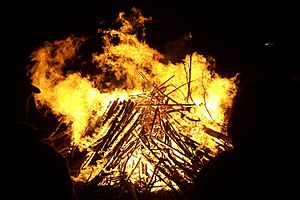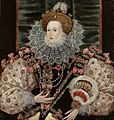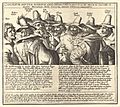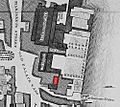Gunpowder Plot facts for kids
The Gunpowder Conspiracy of 1605 was a secret plan to kill King James I of England and VI of Scotland. It is also known as The Powder Treason or The Gunpowder Plot. A group of Catholics wanted to blow up the Houses of Parliament. This was planned for 5 November 1605, during the State Opening of Parliament. The goal was to kill the king and many Protestant nobles.
The people involved also planned to kidnap the king's children. They hoped to start a rebellion in the Midlands after the explosion.
Contents
Who Was Involved?
Robert Catesby led the planning of this secret conspiracy. It began in May 1604. The people who helped him were wealthy Catholics or important families. Catesby might have started the plot because he felt there was little hope for Catholics in England. Many Catholics were unhappy with King James I's rule.
Catesby likely wanted to give Catholics a chance to change things. The plot was meant to be the first step of a rebellion. After the king's death, they hoped to make James' nine-year-old daughter, Princess Elizabeth, the new queen. They wanted her to rule as a Catholic leader.
Other plotters included Thomas Winter, Robert Winter, John Wright, Christopher Wright, Robert Keyes, Thomas Percy, John Grant, Ambrose Rokewood, Sir Everard Digby, Francis Tresham, and Thomas Bates. Guy "Guido" Fawkes was in charge of the explosives. He had 10 years of military experience. Fawkes had fought in wars in the Spanish Netherlands.
Father Henry Garnet, a main Jesuit in England, was said to know about the plot. Another Jesuit, Oswald Tesimond, told him. Robert Catesby had told Tesimond and allowed him to tell Garnet. Garnet was against the plot. But because he learned about it through confession, he could not tell the authorities. Even though he opposed it, Garnet was hanged for treason in 1606.
The Plan
In the 17th century, the Palace of Westminster was a large area with many buildings. These included the old royal palace, Parliament, and law courts. The palace was also more open to the public than it is today. People like merchants and lawyers lived and worked there.
Thomas Percy, who was part of the King's Bodyguard, rented rooms next to the House of Lords in May 1604. The plotters first planned to dig a tunnel under the House of Lords. They wanted to place gunpowder there. Their main goal was to kill King James. But many other important people would also be there, including Protestant nobles and bishops. Guy Fawkes, using the name "John Johnson," pretended to be Percy's servant and looked after the building. Catesby's house in Lambeth was used to store the gunpowder and digging tools.
However, the Black Plague returned to London in the summer of 1604. It was very serious. Because of this, Parliament's opening was moved to 1605. By Christmas Eve 1604, the plotters had not reached Parliament's buildings. When they started digging again in early 1605, they learned Parliament was delayed again, until 3 October.
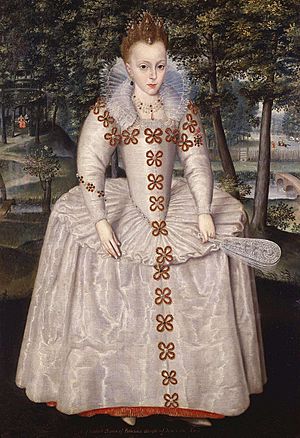
The plotters then found a better opportunity. They learned that a coal merchant had left an empty cellar directly under the House of Lords. Percy quickly rented this cellar. He made up a story that his wife was joining him and he needed more storage space.
Fawkes helped fill this cellar with gunpowder. It was hidden under a pile of wood. By March 1605, they had placed 36 barrels of gunpowder there. If all 36 barrels had exploded, they could have destroyed many buildings in the Old Palace of Westminster. The blast would have broken windows up to one kilometer away.
The conspirators left London in May to avoid suspicion. They planned to meet again in September. But Parliament's opening was delayed once more.
The weakest part of the plan was how they would start a rebellion afterward. They needed money and weapons. Sir Francis Tresham joined the plot. It was probably he who sent an anonymous letter to his brother-in-law, Lord Monteagle. This letter revealed some details of the plot. It warned: "I advise you to devise some excuse not to attend this parliament, for they shall receive a terrible blow, and yet shall not see who hurts them."
Guy Fawkes was left to carry out the explosion. The other plotters went to Dunchurch in Warwickshire to wait for news. After Parliament was destroyed, they planned to start a revolt in the Midlands.
How It Was Discovered
Some plotters worried about their Catholic friends who would be in Parliament. On the evening of Friday, 26 October, Lord Monteagle received an anonymous letter at his house.
My lord out of the love i bare to some of youre frends i have a care of your preseruasion therefore i would advise you as you tender your life to devise some excuse to shift of your attendance at this parliament for god and man hath concurred to punish the wickedness of this time and think not slightly of this advertisement but retire youre self into youre control where you may expect the event in saftey for though there be no appearance of any stir yet i say they shall receive a terrible blow this parliament and yet they shall not see who hurts them this councel is not to be condemned because it may do you good and can do you no harm for the danger is passed as soon as you have burnt the letter and i hope god will give you the grace to make good use of it to whose holy protection i commend you.
Monteagle had the letter read aloud. This might have been to warn the plotters that their secret was out. He quickly gave the letter to Robert Cecil, 1st Earl of Salisbury, the Secretary of State. The plotters found out about the letter the next day. But they decided to continue with their plan. Fawkes checked the cellar and saw that nothing had been touched.
The King saw the letter and ordered Sir Thomas Knyvet to search the cellars under Parliament. Knyvet did this in the early hours of 5 November. Just after midnight, Fawkes was found leaving the rented cellar and was arrested. He gave his name as John Johnson. Inside the cellar, the barrels of gunpowder were found hidden under wood and coal. Fawkes openly admitted his plan to destroy the King and Parliament. He kept pretending to be John Johnson and said he acted alone. Later that morning, he was questioned again.
A letter from Sir Edward Hoby, a Gentleman of the Bedchamber, described who would have been caught in the explosion:
On the 5th of November we began a Parliament, to which the King should have cometh in person, but refrained through a practice but that morning discovered. The plot was to have blown up the King at such time as he should have been sat in his royal throne, Nobility and Commons and with all Bishops, Judges and Doctors at one instant, and the blast to have ruined the whole estate and kingdom of England.
Fawkes was taken to the Tower of London for questioning.
The discovery of the Gunpowder Plot brought great relief to the country. It made Parliament feel very loyal to the king. King James gave a speech on 9 November. He said the plot was the work of only a few Catholics, not all English Catholics. He also said his survival was a miracle, as kings were chosen by God.
What Happened Next?
When the plot failed, the conspirators fled towards Huddington Court near Worcester. This was a family home of Thomas and Robert Wintour. Heavy rain slowed them down. Many were caught by the Sheriff of Worcestershire when they reached Stourbridge.
The remaining men tried to start a revolt in the Midlands. This failed. It ended at Holbeche House in Staffordshire. There was a shootout, and Catesby and Percy were killed. Several other main plotters were captured. Jesuits and others were arrested in other parts of Britain. Some were killed during questioning. Robert Wintour hid for two months before being caught at Hagley Park.
The conspirators were put on trial on 27 January 1606 in Westminster Hall. All of them said they were "Not Guilty," except for Sir Everard Digby. He tried to argue that the King had broken his promises to be more tolerant of Catholicism. Sir Edward Coke, the attorney general, led the prosecution. The trial lasted one day, and the verdict was clear.
The trial was a big public event. People paid money to get in. Four plotters were executed in St. Paul's Churchyard on 30 January. On 31 January, Fawkes, Winter, and others were taken to Old Palace Yard in Westminster. This was in front of the place where they planned the crime. They were to be hanged.
Fawkes avoided the full execution. He jumped from the gallows, breaking his neck and dying instantly.
Henry Garnet was executed on 3 May 1606 at St Paul's. His crime was being the confessor to some plot members. As noted, he had opposed the plot.
Because of the Gunpowder Plot, many Catholics faced difficulties. Some were persecuted or imprisoned in the Tower of London. This included people like Anthony-Maria Browne, 2nd Viscount Montagu and Henry Percy, 9th Earl of Northumberland.
Why Is It Remembered?
In 1604, it seemed unlikely that Catholics would get more freedom to worship. After the plot in 1605, changing the law to be kinder to Catholics became impossible. Catholic Emancipation took another 200 years. However, many important and loyal Catholics still held high positions during King James's rule.
The Gunpowder Plot also made people more interested in evil forces. King James himself had written a book about spirits called Daemonology in 1597. The plot's dark nature partly inspired William Shakespeare's play Macbeth. The play often uses ideas of things being the opposite of what they seem.
The Gunpowder Plot was remembered for many years with special sermons and public events. This included ringing church bells. It became part of England's Protestant celebrations. Over time, this has become today's Bonfire Night.
Some historians have wondered what would have happened if the plot succeeded. If Parliament was destroyed and the king killed, it would likely have led to even harsher actions against Catholics. Without foreign help, the plot probably would not have led to a successful Catholic takeover. Most English people were loyal to the monarchy, even if they had different religious beliefs. England might have become a stricter "Puritan absolute monarchy," like some countries in Europe, instead of following the path of parliamentary reform.
Commemoration
When Parliament met in January 1606, after the plot, they passed an Act of Parliament called the "Thanksgiving Act." This law made annual services and sermons to remember the plot on 5 November. The act stayed in place until 1859. On 5 November 1605, people in London celebrated the plot's failure with fires and street parties. The tradition of ringing church bells and lighting bonfires started soon after. Fireworks were also part of some early celebrations. In Britain, 5 November is also called Bonfire Night, Fireworks Night, or Guy Fawkes Night.
It is still a custom in Britain, around 5 November, to set off fireworks. Traditionally, in the weeks before 5 November, children made "guys." These were effigies, or models, of Fawkes. They were usually made from old clothes stuffed with newspaper and had a scary mask. These "guys" were burned on the bonfire on 5 November. Children would show these effigies in the street to collect money for fireworks. This practice is less common now. The word guy later came to mean an oddly dressed person in the 19th century. In the 20th and 21st centuries, it means any male person.
Towns and organizations often hold firework displays and bonfire parties. People also do this on a smaller scale in their gardens. In some areas, especially in Sussex, local bonfire societies organize large processions, bonfires, and firework displays. The biggest one happens in Lewes.
The Yeomen of the Guard still search the Houses of Parliament before the State Opening of Parliament. However, this is now a tradition rather than a serious security check.
A special British two pound coin was made in 2005. It celebrated the 400th anniversary of the plot.
The cellar where Fawkes watched over his gunpowder was torn down in 1822. The area was further damaged in the 1834 fire and rebuilt. The lantern Guy Fawkes carried in 1605 is in the Ashmolean Museum in Oxford. A key supposedly taken from him is in Speaker's House, Palace of Westminster. These items were shown in an exhibition in Westminster Hall from July to November 2005.
In the American Colonies before the revolution, Guy Fawkes Day was a very popular holiday.
Accusations of Government Involvement
Many people at the time thought that Robert Cecil, 1st Earl of Salisbury was involved in the plot. They believed he wanted to gain favor with the king and pass stricter anti-Catholic laws. These theories suggested that Cecil either created the plot or let it continue after his agents found out about it. This was supposedly for propaganda. These rumors started a long-lasting conspiracy theory about the plot.
However, there was no "golden time" of "toleration" for Catholics that Father Garnet had hoped for. Laws against Catholics were already getting stricter by 1605. There was no major removal of Catholics from power after the Gunpowder Plot. In fact, King James I's reign was a time of relative leniency for Catholics. Few were prosecuted.
This did not stop some from claiming Cecil was involved. In 1897, Father John Gerard wrote a book called What was the Gunpowder Plot?. He claimed Cecil was guilty. Later that year, Samuel Rawson Gardiner argued against this. He said Gerard went too far in trying to "wipe away the reproach" the plot brought on English Catholics. Gardiner believed Cecil was only taking advantage of the situation. Later attempts to prove Cecil's responsibility have also failed due to a lack of evidence. Most historians today do not support the idea that the government set up the plot. They only acknowledge that Cecil might have known about it a few days before it was discovered.
See also
Images for kids
-
A contemporary engraving of eight of the thirteen conspirators, by Crispijn van de Passe. Missing are Digby, Keyes, Rookwood, Grant, and Tresham.
-
The House of Lords (highlighted in red) on John Rocque's 1746 map of London, within the Old Palace of Westminster. The River Thames is to the right.
-
Hindlip Hall in Worcestershire. The building was destroyed by fire in 1820.
-
Edward Coke questioned those thought to be involved with the conspiracy.
See also
 In Spanish: Conspiración de la pólvora para niños
In Spanish: Conspiración de la pólvora para niños



